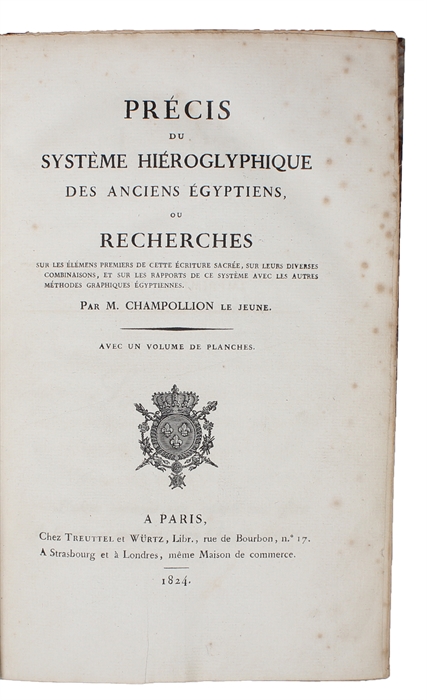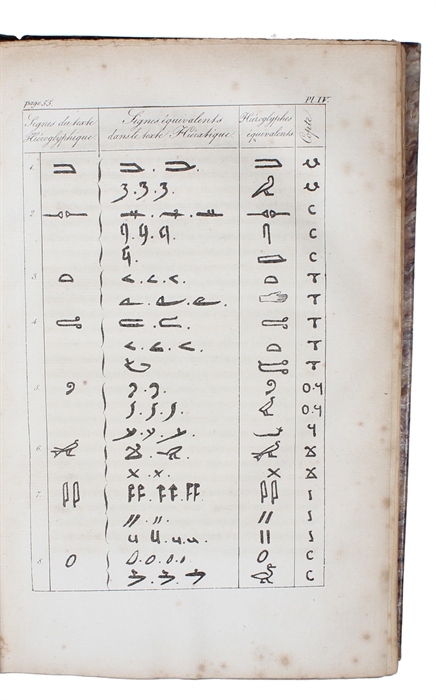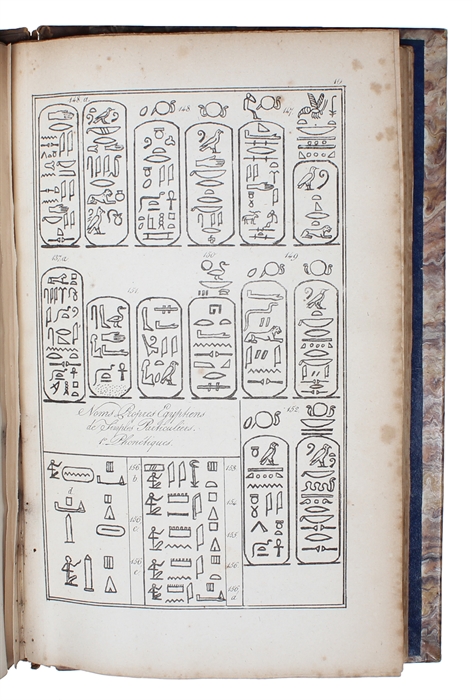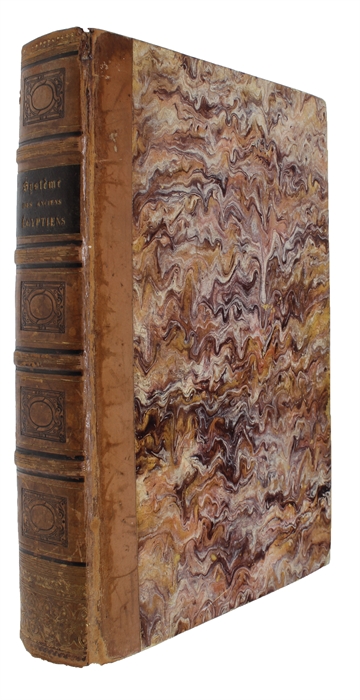THE FINDING OF A LOST LANGUAGE
CHAMPOLLION, M. le jeune.
Précis du système hiéroglyphique des anciens Égyptiens ou recherches sur les élémens premiers de cette écriture sacrée, sur leurs diverses combinaisons, et sur les rapports de ce système avec les autres méthodes graphiques égyptiennes. Avec un volume de planches. + Planches et explication. 2 vols.
Paris, Chez Treuttel et Würtz, 1824.
Lex 8vo. Both volumes bound completely uncut in one near contemporary brown half calf with ornametal spine. A bit of wear to capitals, corners, and hinges. Occasional brownspotting. Overall a very nice copy. (Text-vol.:) (4), XVI, 410, (4, - 1 blank leaf + 1 leaf of book binder instructions) pp. + 16 plates, some folded; (2), 45 pp. + 32 plates (numbered 1-21 and A-K). Complete in two vols. w. all 38 lithographed plates.
Very rare first edition of the work in which the deciphering of the hieroglyphs was fully presented for the first time. In 1822 Champollion had read his "Lettre a M. Dacier" before the Academie des Inscriptions, and for the first time presented the key to reading hieroglyphs. His monumental work "Précis du système hiéroglyphique" appeared two years later, and in this richly illustrated work he presents his definitive, expanded analysis, and finally corrects the misleading mistakes of the other Egyptologists, counting also Thomas Young.
Jean Francois Champollion (1790-1832), the father of Egyptology, is credited with actually deciphering the inscription on the famous Rosetta Stone, translating it, and breaking the mystery of the ancient hieroglyphic script; he is therefore accepted as the founder of Scientific Egyptology, -a title primarily justified with the publication of this work.
The Rosetta Stone was found in 1799 by French Troops and was immediately brought to England, where it has been ever since. The stone was (and is) of the utmost importance to the understanding of the Egyptian language, the principles of which were totally unknown up to this point. Because the hieroglyphic inscription on the stone is accompanied by a Greek and a Demotic one with the same contents, Champollion was able to crack the code of the hieroglyphs and to read a language that had not been read for far more than a millennium.
Champollion was an extraordinary philologist, who, by the age of sixteen, besides Greek and Latin, mastered six ancient Middle Eastern languages, among these Coptic, the knowledge of which, unlike that of Egyptian, was never lost. As the first, Champollion realized the connection between the Coptic and the Egyptian language, and was able to identify many of the Egyptian words on the Rosetta Stone, as he could read them with their Coptic equivalents. He was the first to believe that both Demotic and hieroglyphs represented symbols, and not sounds as earlier presumed. After that he quickly realized that each single hieroglyph could represent a sign, and he began compiling a hieroglyphic alphabet. In his "Précis du système hiéroglyphique" he could finally, in 1824, prove that the glyphs represented sounds as well as concepts, according to context.
Champollion is the constructor of our present code of the hieroglyphic alphabet. "Further study enabled him to discover the values of a number of syllabic hieroglyphic signs, and to recognize the use of hieroglyphs as determinatives. In cases where the Greek text supplied him with the meaning of hieroglyphs of which he did not know the phonetic values, his knowledge of Coptic enabled him to suggest values which he found subsequently to be substantially correct. Further reference to determinatives and the importance of parallel passages and texts will be made later on in his work. Between 1822-24 CHAMPOLLION worked incessantly, and was enabled to modify much of his earlier views, and to develop his Alphabet, -and he evolved some rudimentary principles of Egyptian Grammar. The results of his studies at this period he published in his "Précis du Système Hiéroglyphique", Paris, 1824, wherein he took special pains to inform his readers that his system had nothing whatever to do with that of Dr. YOUNG." (Wallis Budge, The Rosetta Stone in the British Museum, pp. 224-25). "... Ces mémoires réunis formèrent le grand ouvrage publié aux frais de l'Etat en 1824 sous le titre "Précis du système hiéroglyphique des anciens Égyptiens", didié au roi." (N.B.G. Vol. 9, p. 650).
Order-nr.: 56716




